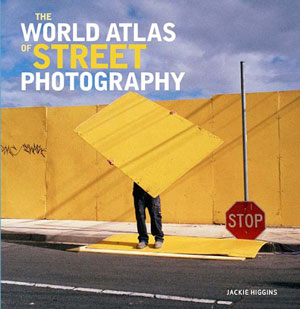Photography, like life itself, changed radically over the past few decades. The photography of city life especially — these days simply called “street photography” — has developed into an own new genre like the new urban scenery itself. Now a book titled The World Atlas of Street Photography showcases the work of 100 contemporary photographers, established and emerging, each with a singular vision of the energy of urban existence.
To some, street photography is like the hunt for light. Take Henri Cartier-Bresson who “prowled the streets all day,” ready to trap a moment when form and light came together in an image that might also contain a metaphor, at the very least, for the unexpected convergences of daily life.

Today, street photography is about much more than decisive moments. Street photography shifts towards the stage, the theater and the cinema. Street photographers are no longer kinda documentary photographers functioning like photojournalists. Street photographers today reinterpret and reimagine the streets.
Candid street photography gives way to a relationship between photography and, say, painting and even the cinema. Street photography has become more elaborate, yet it’s still about photographers chronicling the fever, furor and intimacy of urban life.
With cameras everywhere, “everyday life” today has become a shared subject — and the street has become a shared stage. In The World Atlas of Street Photography we see some of the streets in cities around the world that today’s photographers have chosen to record, each in their own way.
“The energetic, fluctuating pace of the metropolis,” says the book’s Amazon blurb, “has long lured photographers to capture — often candidly — the chaos, character and incident of modern urban life ever since the genesis of photography in the 19th century. The World Atlas of Street Photography focuses on the abundance of photos created on street corners internationally, including classic documentary street photography as well as mediated images of urban landscapes, staged performances and sculpture.”
Here some quotes from the book:
Posing for a portrait is quite a common thing, but it is another thing entirely to meet up with a stranger. (Katy Grannan, Los Angeles)
I am trying to show how photography permeates public territories and infiltrates our lives. (Rut Blees Luxemburg, London)
What I’m after is that fleeting tenth of a second when the tension is at its most extreme… when anything could happen, or nothing. (Mohamed Bourouissa, Paris)
The city continually and rapidly expands, always generating crisis. (Julio Bittencourt, São Paulo)
In the act of love, as in photography, there is a form of life and a kind of slow death. (Nobuyoshi Araki, Tokyo)
I wanted to find a way to deal with real events. To get away from my own imagination… out of the studio, but not to relinquish certain advantages which I felt I’d gained there. (Jeff Wall, Vancouver)
The World Atlas of Street Photography is available on Amazon.


